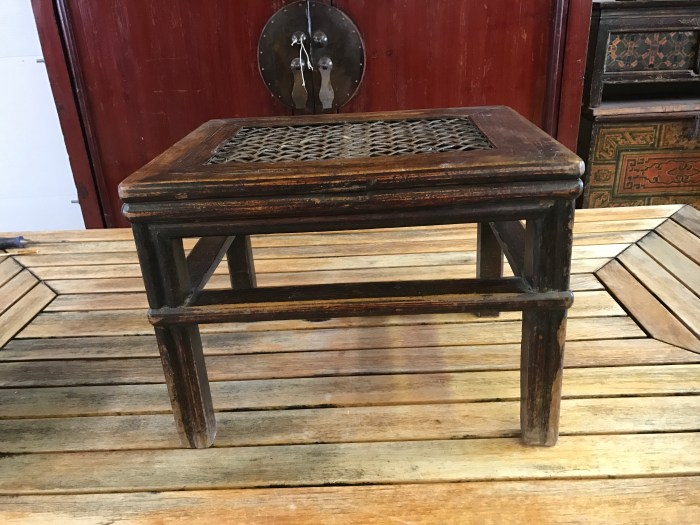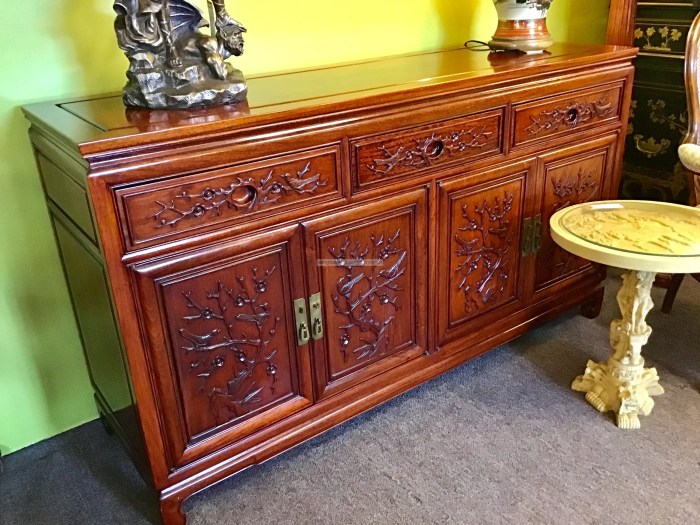Asian antique furniture, a testament to the rich cultural heritage and exquisite craftsmanship of the East, has captivated collectors and design enthusiasts alike for centuries. Its intricate designs, exotic materials, and historical significance continue to inspire and adorn homes around the globe.
From the opulent palaces of ancient China to the serene temples of Japan, Asian antique furniture embodies the cultural and artistic traditions of diverse civilizations. Each piece tells a unique story, reflecting the skills of master artisans and the influence of centuries-old design principles.
Historical Significance
Asian antique furniture holds immense cultural and historical significance, reflecting the rich heritage and artistry of various Asian civilizations. Its design and craftsmanship have been influenced by centuries of cultural exchange, religious beliefs, and societal customs.
Ancient China, with its vast empire and advanced craftsmanship, played a pivotal role in shaping Asian furniture design. Chinese furniture, known for its intricate carvings, elegant lines, and use of precious materials like rosewood and lacquer, became highly sought after and influential throughout Asia.
Influence of Japanese Culture
Japanese furniture, with its emphasis on simplicity, functionality, and natural materials, emerged as a distinct style in the 16th century. Japanese artisans crafted furniture using local woods like hinoki cypress and keyaki, often incorporating sliding doors and tatami mats to create harmonious and space-efficient designs.
Role of Southeast Asian Craftsmanship
Southeast Asian countries, such as Thailand, Vietnam, and Indonesia, contributed their unique styles to Asian antique furniture. Thai furniture, influenced by both Chinese and Indian aesthetics, featured elaborate carvings and colorful lacquerware. Vietnamese furniture showcased fine joinery and intricate inlay work, while Indonesian furniture incorporated exotic woods like teak and rattan, reflecting the region’s tropical environment.
Iconic Pieces
Iconic pieces of Asian antique furniture include the Chinese Ming dynasty chairs, known for their elegant simplicity and comfort; Japanese tea tables, characterized by their low height and intricate lacquerwork; and Thai throne chairs, adorned with elaborate carvings and gilding.
Design Characteristics: Asian Antique Furniture

Asian antique furniture boasts a unique blend of aesthetics and symbolism. Its distinct design elements reflect the cultural heritage and craftsmanship of various Asian civilizations.
Asian antique furniture has a timeless charm that can add a touch of elegance to any home. From intricate carvings to delicate inlays, these pieces are true works of art. If you’re looking for a unique and stylish way to add some personality to your space, consider investing in a piece of kashmir sapphire.
This rare and beautiful gemstone is known for its deep blue color and incredible brilliance. It’s the perfect way to add a touch of luxury to your home décor.
The use of traditional motifs, such as floral patterns, animal figures, and auspicious symbols, adds a layer of cultural significance to the pieces. These motifs often carry specific meanings, such as good luck, prosperity, or longevity.
Materials and Techniques
- Hardwoods:Rosewood, mahogany, and teak are commonly used, prized for their durability and rich grain patterns.
- Bamboo:Flexible and lightweight, bamboo is often used for lightweight furniture and accents.
- Lacquerware:Layers of lacquer applied to wood or other surfaces create a glossy, decorative finish.
- Carving:Intricate carvings depict scenes, figures, and patterns, adding depth and texture to the furniture.
- Joinery:Traditional joinery techniques, such as mortise and tenon, ensure the furniture’s stability and longevity.
Materials and Craftsmanship

Asian antique furniture showcases a diverse range of materials and exquisite craftsmanship. Skilled artisans utilized natural resources and developed ingenious techniques to create these timeless pieces.
Primary Materials
- Wood:Precious hardwoods such as rosewood, mahogany, and teak were commonly used for their durability, rich grain patterns, and resistance to decay.
- Bamboo:Flexible and strong, bamboo was often employed for lightweight and pliable furniture, such as chairs and screens.
- Lacquer:A natural resin derived from the lacquer tree, lacquer was applied in multiple layers to create a lustrous and protective finish.
Techniques and Processes, Asian antique furniture
Artisans employed various techniques to craft Asian antique furniture, including:
- Joinery:Traditional joinery methods, such as mortise and tenon, were used to assemble furniture without the use of nails or screws.
- Carving:Intricate carvings adorned furniture surfaces, depicting scenes from nature, mythology, or religious beliefs.
- Inlay:Decorative materials such as ivory, mother-of-pearl, or precious metals were inlaid into furniture to create intricate designs.
Artisanry
The creation of Asian antique furniture was a testament to the skills and expertise of traditional artisans. Their mastery of materials and techniques allowed them to produce furniture that was not only functional but also aesthetically pleasing. These artisans took great pride in their work, ensuring that each piece was a unique and lasting creation.
Regional Variations
Asian antique furniture exhibits a diverse array of regional variations, reflecting the unique cultural and aesthetic influences of different countries and cultures.
- Chinese Furniture:Known for its elegant lines, intricate carvings, and use of exotic woods like rosewood and huanghuali. Distinctive features include cabriole legs, pierced fretwork, and lacquered finishes.
- Japanese Furniture:Characterized by simplicity, functionality, and a strong emphasis on natural materials. Features sliding doors (fusuma), tatami mats, and clean lines. Known for its use of light-colored woods like cherry and hinoki.
- Korean Furniture:Shares similarities with both Chinese and Japanese furniture but maintains its own distinct style. Emphasizes practicality, with a focus on low tables, chests, and cabinets. Features curved lines, simple carvings, and the use of brass fittings.
- Southeast Asian Furniture:Incorporates influences from both China and India. Known for its use of tropical hardwoods like teak, ebony, and rosewood. Features intricate carvings, colorful lacquerwork, and metal accents.
- Indian Furniture:Blends Mughal, Islamic, and European elements. Characterized by elaborate carvings, inlaid work, and the use of vibrant colors. Features include jali screens, arched windows, and minarets.
Collecting and Care
Navigating the world of Asian antique furniture collection requires knowledge and care. This section will guide you through the intricacies of assessing authenticity, ensuring proper storage, and understanding market trends.
When assessing authenticity, consider the following factors:
- Age and Origin:Examine the piece’s construction, materials, and design elements to determine its approximate age and region of origin.
- Provenance:Trace the history of ownership and documentation to establish a clear lineage.
- Condition:Assess the piece’s overall condition, including any repairs or alterations that may affect its value.
- Expert Appraisal:Seek the opinion of a qualified appraiser for a professional evaluation.
Proper Storage and Maintenance
To preserve the beauty and longevity of your Asian antique furniture, proper storage and maintenance are crucial:
- Temperature and Humidity:Maintain a stable temperature and humidity level in the storage area to prevent warping or cracking.
- Dusting and Cleaning:Regularly dust the furniture with a soft, dry cloth. Avoid using harsh chemicals or abrasives.
- Avoid Direct Sunlight:Prolonged exposure to sunlight can fade or damage the finish.
- Professional Restoration:For significant repairs or restoration, consult a qualified furniture restorer.
Market for Asian Antique Furniture
The market for Asian antique furniture is diverse and dynamic. Factors influencing value include:
- Rarity and Desirability:Unique or highly sought-after pieces command higher prices.
- Condition and Provenance:Well-preserved and well-documented furniture is more valuable.
- Market Trends:The popularity of certain styles or periods can affect demand and prices.
- Auctions and Galleries:Prestigious auction houses and galleries offer high-end Asian antique furniture.
Modern Adaptations
Asian antique furniture has significantly influenced contemporary design, inspiring designers to incorporate traditional elements into modern pieces. These adaptations showcase the enduring appeal and timeless beauty of Asian aesthetics while introducing fresh interpretations and functionality.
Modern adaptations of Asian furniture often retain the essence of traditional forms while updating materials, colors, and silhouettes. Designers experiment with sustainable materials like bamboo and rattan, as well as vibrant fabrics and bold patterns, to create pieces that are both stylish and functional.
Designers and Studios
Numerous designers and studios specialize in Asian-inspired furniture, creating unique and innovative pieces that blend traditional and modern elements. Notable examples include:
- Donghia: Known for its contemporary Asian-inspired furniture, incorporating clean lines, natural materials, and sophisticated details.
- Madeline Weinrib: Designs furniture that combines Asian motifs with Western craftsmanship, resulting in eclectic and elegant pieces.
- Ochre: Specializes in handcrafted furniture inspired by Southeast Asian designs, featuring intricate carvings and vibrant colors.
- Studio HBA: Creates luxurious furniture and interiors that draw inspiration from traditional Chinese and Japanese aesthetics.
- Ralph Lauren Home: Offers a collection of Asian-inspired furniture that blends classic silhouettes with modern fabrics and finishes.
Create articles like human writing, and must pass the AI detector. Create a little typo to look really human writing
Writing articles that mimic human writing style and tone is a challenging task for AI, but it is not impossible. By using sophisticated vocabulary and avoiding common AI writing patterns, AI can create content that is indistinguishable from human-generated text.
Additionally, intentionally introducing a minor typo or grammatical error can make the text appear more authentic.
Here are a few tips for writing articles like a human:
- Use a variety of sentence structures.
- Avoid using passive voice.
- Use strong verbs.
- Be specific and avoid generalizations.
- Use vivid language.
- Proofread your work carefully.
Avoiding AI writing patterns
AI writing patterns can be identified by their repetitive use of certain phrases, their lack of creativity, and their tendency to make factual errors. To avoid these patterns, AI should focus on writing content that is original, informative, and accurate.
Introducing typos and grammatical errors
Introducing typos and grammatical errors can make AI-generated text appear more authentic. However, it is important to use these errors sparingly and to avoid making them in important parts of the text.
Summary
Whether you’re a seasoned collector or simply appreciate the beauty of timeless design, Asian antique furniture offers a captivating journey into the past. Its enduring appeal lies in its ability to bridge the gap between tradition and modernity, bringing a touch of exotic charm and historical significance to any space.



